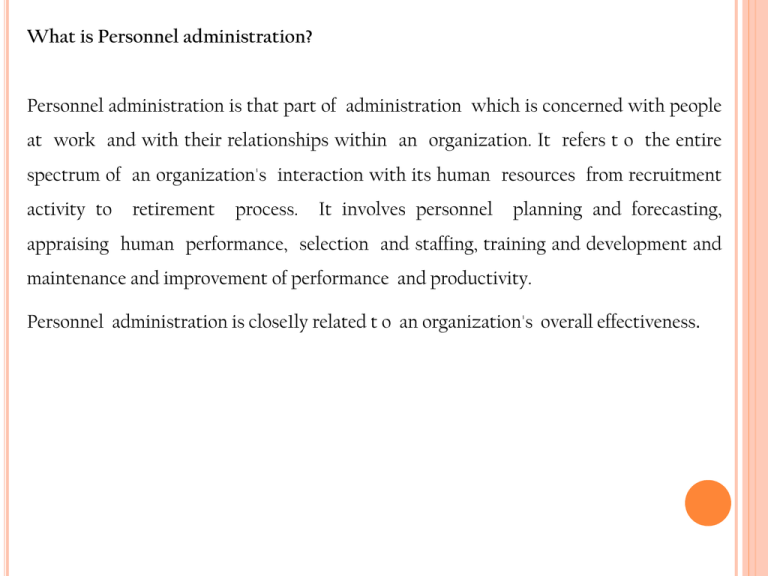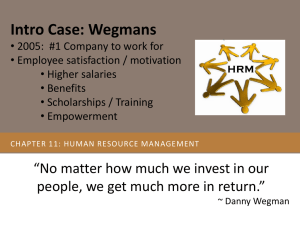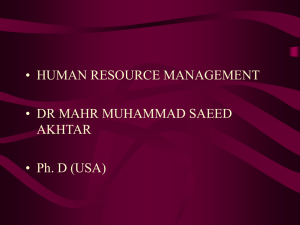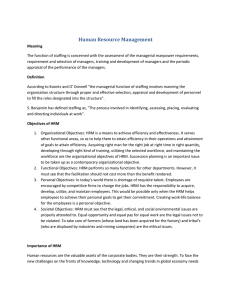sir_Presentation_Personnel Administration
advertisement

What is Personnel administration? Personnel administration is that part of administration which is concerned with people at work and with their relationships within an organization. It refers t o the entire spectrum of an organization's interaction with its human resources from recruitment activity to retirement process. It involves personnel planning and forecasting, appraising human performance, selection and staffing, training and development and maintenance and improvement of performance and productivity. Personnel administration is close1ly related t o an organization's overall effectiveness. personnel administration aims at : •Effective utilization of human resources. •Desirable working relations among all members of the organization •Maximum development. •Meeting the organization's social a n d legal responsibilities Personnel function is concerned with the procurement, development, compensation, integration and maintenance of the personnel of an organization for the purpose of contributing toward the accomplishment of that organization's major goals and objectives In particular, personnel management is concerned with the development of policies governing : •Manpower planning, recruitment, selection, placement and termination. •Education and training, career development. •Terms of employment , methods and standards of remuneration. •Working conditions and employees' services. •Formal and informal communication and consultation both through the representatives of employers and employees and at all levels throughout the organization. •Negotiation a n d application of agreements on wages and working conditions,procedures for the avoidance and settlement of disputes. Human Resource Manageme nt Managers must find ways to get the highest level of contribution from their workers. And they will not be able to do that unless they are aware of the many ways that their understanding of diversity relates to how well, or how poorly, people contribute. R. Roosevelt Thomas Jr., p 320 Human Resource Management The process of attracting, developing and maintaining a talented and energetic workforce to support organisational mission, objectives and strategies. p 321 Human Resource Management A distinctive approach to employment management which seeks to achieve competitive advantage through the strategic deployment of a highly committed and capable workforce, using an integrated array of cultural, structural and personnel techniques. HRM Includes: Employment Issues Discrimination, Equal Employment Opportunity Harassment Affirmative Action Diversity Management Occupational Health and Safety Industrial Relations HRM Includes: Employment Issues Recruitment Selection Induction / Orientation Training and Professional Development Performance Appraisal and Management Career Development Quality of Work Life Retention and Turnover PRINCIPLES OF HRM Strategic integration Organisational flexibility Commitment Quality STRATEGIC INTEGRATION An attempt to treat all labour management processes – from recruitment and training to remuneration and retrenchment – in a strategic fashion by integrating them with the broader business concerns of the enterprise. STRATEGIC HRM People are not just another cost or factor of production. They are the key to competitive advantage. Close ‘fit’ between human resources, internal processes and the external environment. 1. Devolution of responsibility for labour management to line managers. 2. Co-ordination of policies on recruitment, training & performance management. FLEXIBILITY 1. 2. The flexible firm and the global economy. Functional flexibility Numerical flexibility Financial flexibility Core: Highly skilled knowledge workers. Full time jobs and job security. Periphery: Casuals and part-time workers and short-term contractors. COMMITMENT From ‘control’ to ‘commitment’ through changing the organisation’s culture. Mission statement: A statement of core values. Recruitment: Only recruiting those prepared to subscribe to these core values. CONT’D ‘Transformational leadership’: CEO as visionary change agent. Ensuring employees demonstrate desired attitudes, competencies and behaviours. Culture Management – strong culture QUALITY Culture of quality: Quality work, quality workers, quality products and services. Total Quality Management. Quality assurance and zero defects. Internal customers. Empowering working. workers via team HRM VS PERSONNEL MANAGEMENT Integral part of line management responsibilities. Emphasises the management of organisational culture as the central activity of senior management. HRM represents the discovery of personnel management by chief executives. THE PRACTICE OF HRM Does the rhetoric match the reality? Strategic integration. Line managers and devolution. Empowered or merely over burdened? Delayering, re-engineering and the elimination of the jobs of middle management. HR MANAGERS AND STRATEGIC DECISIONMAKING Downsizing of personnel departments. Strategic HR planning. Consulting firms. Devolution of administrative functions. Contracting-out of HR functions. HRM ACTIVITIES Job analysis defines a job in terms of specific tasks and responsibilities and identifies the abilities, skills and qualifications needed to perform it successfully. Human resource planning or employment planning is the process by which an organisation attempts to ensure that it has the right number of qualified people in the right jobs at the right time. Employee recruitment is the process of seeking and attracting a pool of applicants from which qualified candidates for job vacancies within an organisation can be selected. Employee selection involves choosing from the available candidates the individual predicted to be most likely to perform successfully in the job. HRM ACTIVITIES (CONT) Performance appraisal is concerned with determining how well employees are doing their jobs, communicating that information to the employees and establishing a plan for performance improvement. Training and development activities help employees learn how to perform their jobs, improve their performance and prepare themselves for more senior positions. Career planning and development activities benefit both employees (by identifying employee career goals, possible future job opportunities and personal improvement requirements) and the organisation (by ensuring that qualified employees are available when needed). Employee motivation is vital to the success of any organisation. Highly motivated employees tend to be more productive and have lower rates of absenteeism Organisational Planning Process Strategic Plan (5 yrs) Human Resource Development Challenges Succession Planning Business Plan (2-3 yrs) Branch Plan (1 yr) Professional Development And Training Everybody Needs Team Plan (1 yr) Individual Plan (1 yr) Branch Needs Individual Review (Ideal Case) Review Induction / Orientation Key Tasks Development Plan Review Recruitment and Selection Team Needs Organisational and Cultural Definitions Assessment (Survey?) Organisational and Cultural Behaviours Individual Needs Job-Related Skills and Knowledge







